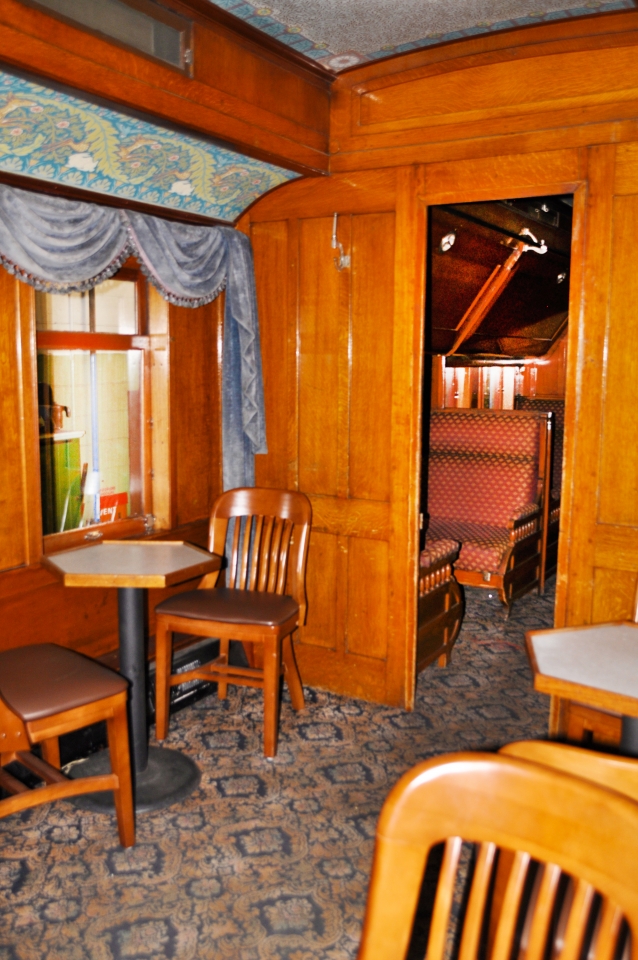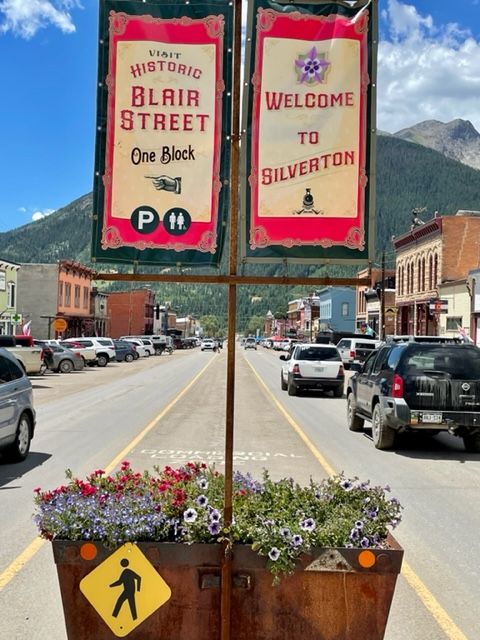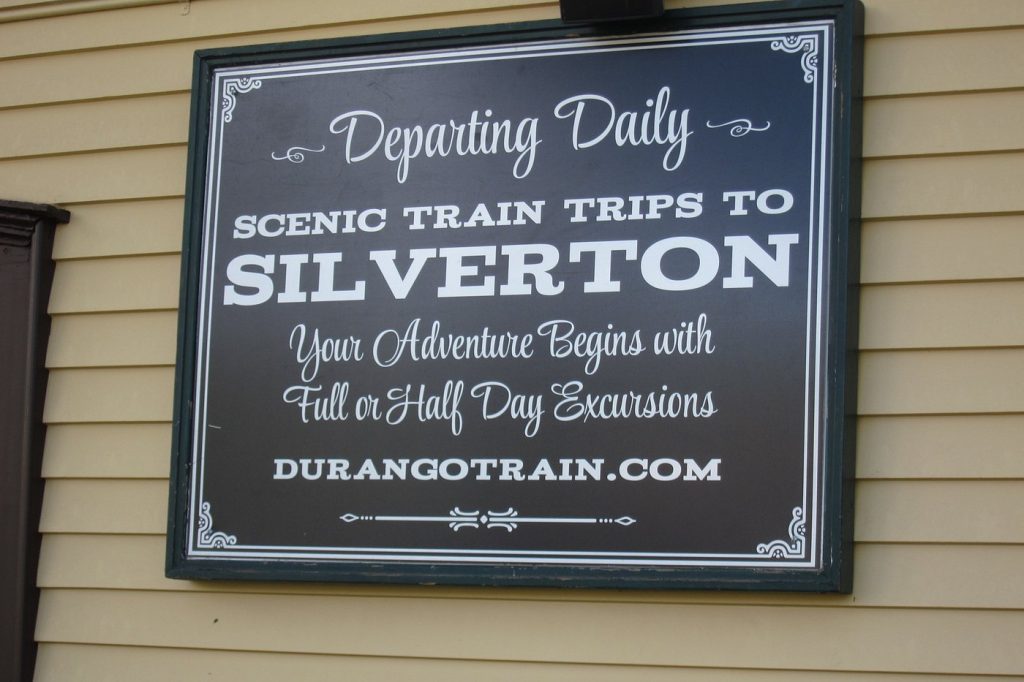If you’ve ever spent a summer in Phoenix, AZ, you know it’s hot! Yeah, yeah, yeah, it’s a dry heat, but it is still feels like a sauna. So, I like to get out of town, even for just a few days at a time, go somewhere cooler, and then when I return, it is that much closer to blessed relief!
Durango, CO was a perfect choice for a quick get-away, as it is about 450 miles (an easy day’s drive) and there is plenty to see along the way. For time’s sake, I only made one stop: 4 Corners National Monument, which is where you can stand in Arizona, New Mexico, Utah and Colorado all at the same time! It cost $8.00, and once inside the compound, there were booths offering Native American jewelry, art and souvenirs, as well as some picnic tables to sit and refresh. I stood in line for about 10 minutes (but I could see that if the line were longer than a few people, it could take quite a while), asked a friendly bystander to take my photo, and then I was back on the road.


Surrounded by the San Juan Mountains in Colorado, Durango is a mountain town (6512 feet above sea level) with over 300 days of sunshine and over 260 inches of snow per year (with delighted ski lovers flocking to Purgatory Resort for its pristine snow under blue skies). It was founded in 1880 by the Denver & Rio Grande Railroad Company, and to this day, the train is one of its most interesting attractions (which I will come back to momentarily). I found the town to be a fascinating blend of the old west, mining, Native American influences, and outdoor adventure, with a nice downtown shopping street and a grand tree-lined promenade of charming historic homes.

Speaking of charming homes, whenever I go to a new town, I try to find the historic neighborhood to ogle the houses from a by-gone era, and certainly, 3rd Avenue did not disappoint! Located along the bluffs overlooking the downtown, this residential area, called Noe Hill, is one of the best collections of late 19th and early 20th century architecture, and as an added bonus, it has a median of mature trees that make the boulevard even more gracious with its dappled sunlight. I’ve borrowed a few photos from NoeHill.com (since they were so much better than mine) to give you a glimpse into history.


For a town of less than 20,000, there was a surprising array of interesting boutiques, art galleries and eclectic restaurants on Main Street, the historic downtown shopping district. I found several Christmas gifts, including a pair of handmade copper horse towel racks at the Durango Antique Market (ssshhh – it’s a gift I haven’t given yet!). Just a couple blocks north of Main Street is the Strater Hotel, built in 1887, which boasts an extensive collection of American Victorian walnut antiques and many other period details like handcrafted woodwork and original wallpaper. For those who like off-beat trivia, Louis L’Amour wrote a set of western novels, the Sackett Series, while staying at the Strater. The point is, even if you are just window shopping, wandering about or looking for a great place to eat and people-watch, the atmosphere and history of the downtown is worth your time.






One of the main reasons I wanted to visit was the train. It is the jewel in Durango’s crown! I signed up for the Cinco Animas car on the diesel train (there is also a steam engine train that departs 45 minutes later), and it was a throwback to the elegant style of travel in the late 1800’s/early 1900’s. The seating was not particularly comfortable for a 3.5 hour ride each way, but it was a small sacrifice for the beauty of the scenery and the sense of luxury enhanced by original light fixtures, Victorian wallpaper, elaborate cornices and a private butler (who was an absolute delight and one of the highlights of the day!).



So, you may be wondering what makes the train so special. I’m glad you asked! Below, I have cut and pasted information on the history of the train from their website: www.DurangoTrain.com (so you’re getting it straight from the horse’s mouth!). But in summary, narrow gauge rails are only 36 inches apart, while standard rails are 56 inches apart, and there are only 2 railways still functioning utilizing the outdated system (most were constructed in the 1800’s and were abandoned by the 1950’s). On the trip from Durango to Silverton, it is obvious why narrow gauge had to be used: in some places the train runs close enough to the mountainside to touch the rocks and close enough to the edge you can’t see any support!



To say the scenery is stunning would be an understatement! High mountain peaks, deep gorges, the rushing Animas River (which you cross over a number of times on the journey), landscape that looks completely different from one season to the next, and if you get lucky, wildlife galore. So, after enjoying nature at its best, the train arrived in Silverton for a 2 hour layover before the return trip.
At the height of its popularity in 1883 as a center for numerous mining camps, Silverton counted a population of 2000 residents and 400 buildings, most of which were saloons. Despite mining operations ceasing in the 1990’s, the town retains the feel of the gold rush days with crooked sidewalks, hand-painted store signs and old west town facades. I wasn’t sure what to expect from the shopping (was everything going to be imported from China??), but there was actually a diverse selection, from T-shirts and kitschy souvenirs, to hand-poured soaps, to western wear, to astorite jewelry (a rare pink semi-precious stone only mined locally).






My 2 hours was up practically before I blinked, and it was back to the train for the return to Durango. Upon disembarking, I took a few minutes to explore the train museum, which is just down the platform from the depot. A few minutes did not do it justice! It went on forever, and for a train enthusiast like The Big Bang Theory’s Sheldon Cooper, it would be like Disneyland! In the theater car, there is an informative video about the history of the Durango & Silverton Narrow Gauge Railroad, as well as interactive exhibits and knowledgeable staff onsite to engage with inquisitive visitors. Best of all, its free!

What a wonderful day! Really, my whole time in Durango was lovely (2 full days and a partial day after the drive). It was enough time for what I wanted to do, but if you want outdoor adventure, there is a lot to do and you could spend a lot more time. I hope you are inspired to visit!
Some links to help you plan your trip:
https://www.downtowndurango.org/
https://www.durangotrain.com/dsng-museum-durango/
https://www.historycolorado.org/mining-industry-colorado


Train History (courtesy of DurangoTrain.com)
Durango was founded by the Denver & Rio Grande Railway in 1880. The railroad arrived in Durango on August 5, 1881 and construction on the line to Silverton began in the fall of the same year.
Durango was founded by the Denver & Rio Grande Railway in 1880. The railroad arrived in Durango on August 5, 1881 and construction on the line to Silverton began in the fall of the same year. By July of 1882, the tracks to Silverton were completed and the train began hauling both passengers and freight.
From the very beginning, the railroad was promoted as a scenic route for passenger service although the line was constructed primarily to haul mine ores, both gold and silver, from the San Juan Mountains. It is estimated over $300 million in precious metals has been transported over this route.
By 1885 the population of Silverton had grown to 1100 and Otto Mears completed the toll road to Ouray and additional narrow gauge track out of Silverton was laid down in 1887. In 1893, 10 large mines in the Silverton district were forced to close when silver prices dropped from $1.05/oz to $.63/oz. Just three years later the Yankee Girl and Guston Mines played out. In Durango, the fire of 1889 virtually destroyed downtown and the first automobile arrived by train in 1902. By 1906, Mesa Verde was designated a National Park, increasing the potential for tourism promotions.
Throughout the next twenty years the railroad faced many challenges; slides, floods, snow, war and financial instability. When the US Government entered WW I, it assumed operation of the railroad. Shortly after resuming control of railroad operations, the D&RGW reorganized due to financial difficulties. Silverton suffered devastating effects from the Spanish Flu Epidemic of 1918 – 10 percent of the population died in just six weeks! In addition, the Gold King Mine closed, the Sunnyside Mine temporarily ceased operations for almost ten years and the Silverton Railroad closed.
With the advent of WW II, the US Government requisitioned narrow gauge equipment to use in Alaska and the smelter in Durango reopened to process uranium for use in the war. The smelter continued to process uranium instead of silver into the late 1940’s due to the Cold War. By 1947 the Silverton branch was in danger of being abandoned. A determined staff stepped in and helped to promote tourism keeping the line alive. Then Hollywood discovered Durango and the railroad. Over the next ten years several movies were filmed in the area showcasing the train: Ticket to Tomahawk, Across the Wide Missouri, Denver & Rio Grande, Viva Zapata and Around the World in 80 Days.
During the latter part of the 1960s, the Durango-Silverton was registered as a National Historic Landmark and was awarded as a National Historic Civil Engineering Landmark. In 1969 the D&RGW abandoned the tracks south of Durango isolating the line and leaving the future of the line in question. Hollywood continued its fascination with the area and the railroad with the filming of Butch Cassidy and the Sundance Kid. As the railroad prepared to celebrate its 100th birthday, Charles E. Bradshaw, Jr. purchased the Silverton branch and with the restoration process complete, engine #481 returned to service after 20 years in retirement.
Courtesy of DurangoTrain.com



